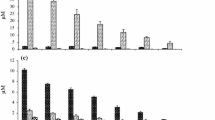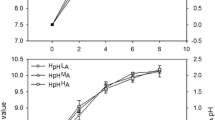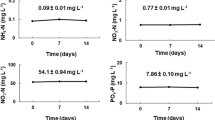Abstract
To investigate the ecological effect of macroalgae on de-eutrophication and depuration of mariculture seawater, the variation of dissolved inorganic nitrogen (DIN) and phosphate (DIP), the amount of Vibrio anguillarum, and total heterotrophic bacteria in Ulva clathrata culture, as well as on the algal surface, were investigated by artificially adding nutrients and V. anguillarum strain 65 from February to April 2006. The results indicated that U. clathrata not only had strong DIN and DIP removal capacities, but also showed a significant inhibitory effect on V. anguillarum, although not reducing the total heterotrophic bacteria. Vibrio anguillarum 65 dropped from 5∼8 × 107 cfu mL−1 to 10 cfu mL−1 (clone-forming units per mL) in 10 g L−1 of fresh U. clathrata culture within 2 days; i.e., almost all of the Vibrios were efficiently eradicated from the algal culture system. Our results also showed that the inhibitory effect of U. clathrata on V. anguillarum strain 65 was both DIN- and DIP-dependent. Addition of DIN and DIP could enhance the inhibitory effects of the algae on the Vibrio, but did not reduce the total heterotrophic bacteria. Further studies showed that the culture suspension in which U. clathrata was pre-cultured for 24 h also had an inhibitory effect on V. anguillarum strain 65. Some unknown chemical substances, either released from U. clathrata or produced by the alga associated microorganisms, inhibited the proliferation of V. anguillarum 65.




Similar content being viewed by others
References
Anguiano-Beltran C, Searcy BR, Lizarrage PML (1998) Pathogenic effects of Vibrio alginolyticus on larvae and postlarvae of the red abalone Haliotis rufescens. Dis Aquat Org 33:119–122
Burkholder P, Burkholder L, Almodovar L (1960) Antibiotic activity of some marine algae of Puerto Rico. Bot Mar 2:149–156
Caccamese S, Toscano RM, Furnari G, Cormaci M (1985) Antimicrobial activities of red and brown algae from southern Italy coast. Bot Mar 28:505–507
Chapman ARO, Craigie JS (1997) Seasonal growth in Laminaria longicruris: Relations with dissolved inorganic nutrients and internal reserves of nitrogen. Mar Biol 40:197–205
Chopin T, Yarish C, Wikes R, Belyea E, Lu S, Mathieson A (1999) Developing Porphyra/Salmon integrated acquaculture for bioremediation and diversification of the aquaculture industry. J Appl Phycol 11:463–472
Cohen I, Neori A (1991) Ulva rigida biofilters for marine fishpond effluents: I. Ammonia uptake kinetics and nitrogen content. Bot Mar 34:475–482
Diao HX (1983) A Study of the determination of ammonia in sea water with automatic analyzer oxidation process of sodium hypobromite. Mar Sci 1:25–28
Egidius E (1987) Vibriosis: pathogenicity and pathology. Aquaculture 67:15–28
Gao FM, Zhang SH, Wang XY, Liang ZP, Xu L, Wu BS (1980) Study on the determination of ammonia-nitrogen in seawater with the sodium hypobromite oxidation method. Trans Ocean Limn 4:41–47
Haglund K, Pedersen M (1993) Outdoor pond cultivation of the subtropical marine red alga Gracilaria teniustipata in brackish water in Sweden. Growth, nutrients uptake, co-cultivation with rainbow trout and epiphyte control. J Appl Phycol 5:271–284
Hellio C, Bremer G, Pons AM, Le Gal Y, Bourgougnon N (2000) Inhibition of the development of microorganisms (bacteria and fungi) by extracts of marine algae from Brittany, France. Appl Microbiol Biotech 54:543–549
Huang XP, Zhu XB, Liu JG, Wang XT, Xu WH, Kang XL (2004) Study on enrichment of N, P and purification of water quality by several species of algae. Mar Sci 28(12):39–42
Huang XH, Li CL, Zheng L, Liu CW, Wang RX (2005) Effects of the immobilized microalgae on the quantity dynamics of Vibrio in the shrimp ponds. Acta Hydrobiol Sinica 29:684–688
Jiménez del Río M, Ramazanov MZ, García-Reina G (1994) Optimization of yield and biofiltering efficiences of Ulva rigida C. Ag. cultivated with Sparus aurata L. Waste waters. Sci Mar 58:329–335
Krom MD, Ellner S, Vanrijn J, Neori A (1995) Nitrogen and phosphorus cycling and transformations in a prototype non-polluting integrated mariculture system. Mar Ecol Prog Ser 118:25–36
Li XC, Zhang GC, Cui YA, Lei YZ (1998) Static purification of Ulva Pertusa Kjellman for abalone effluents. Trans Chin Soc Agri Engi 14(1):173–176
Liao WR, Lin JY, Shieh WY, Jeng WL, Huang R (2003) Antibiotic activity of lectins from marine algae against marine Vibrios. J Indust Microbiol Biotech 30:433–439
Lin GH (1991) The main problems in the cure of shrimp diseases. Mar Sci 2:72–73
Lin W, Chen D (1998) Significance of study on microalgae-bacteria relation in mariculture. Mar Sci 4:34–37
Lin W, Chen D, Liu XY (2001) The antivibrio mechamism of microalgae cultivation system. Ocean Limn Sinica 32(1):7–14
Liu JG, Wang ZF, Lu KG et al (2006) Comparison of abilities of several macroalgae in removing inorganic nitrogen. Oceanol Limnol Sinica, Supplement to 37:255–262
Marinho-Soriano E, Morales C, Moreira W (2002) Cultivation of Gracilaria (Rhodophyta) in shrimp pond effluents in Brazil. Aquacult Res 33:1081–1086
Murphy J, Riley JP (1962) A modified single solution method for determination of phosphate in natural waters. Annu Chim Acta 27:31–36
Nelson GS, Glenn EP, Corm J, Moore D, Walsh T, Akutagawa M (2001) Cultivation of Gracilaria parvispora (Rhodophyta) in shrimp-fam effluent ditches and floating cages in Hawaii: a two-phase polyculture system. Aquaculture 192:239–248
Neori A, Cohen I, Gordin H (1991) Ulva lactuca biofilters for marine fishponds effluents: II. Growth rate, yield and C:N ratio. Bot Mar 34:483–489
Nishimori E, Hasegawa O, Numata T, Wakabayashi H (1998) Vibrio carchariae cause mass mortalities in Japanese abalone, Suculus diversicolor supratexta. Fish Pathol 33:495–502
Pang SJ, Xiao T, Shan TF, Wang ZF, Gao SQ (2006) Evidences of the inter tidal red alga Grateloupia turuturu in turning Vibrio parahaemolyticus into non-culturable state in the presence of light. Aquaculture 260:369–374
Ryther JH, Goldman JC, Gifford CE, Huguenin JE, Wing AS, Clarner JP, Williams LD, LaPointe BE (1975) Physical models of integrated waste recycling marine polyculture systems. Aquaculture 5:163–177
Shi ZL, Dai GS, Wang H, Huang YF, Ju AY (1980) Determination of nitrate in sea water by cadmium-copper reduction method. J Shandong College Ocean 10(3):53–63
Sohier LP, Bianchi MAG (1985) Development of a heterotrophic bacterial community within a closed prawn aquaculture system. Microb Ecol 11:353–369
State Oceanic Administration P.R. China (2003) Review of China Oceanic Disaster. State Oceanic Administration, Beijing
State Oceanic Administration P.R. China (2005) Bulletin of Marine Environmental Quality of China. State Oceanic Administration, Beijing
Tan HX, Zhu XB, Luo GZ (2001) Preliminary study on constitution of algal turf scrubber equipment in closed recirculating culture system. J Shanghai Fish Univ 10(3):276–278
Vandemeulen H, Gordin H (1990) Ammonium uptake using Ulva (Chlorophyta) in intensive fishpond systems:mass culture and treatment of effluent. J Appl Phycol 2:363–374
Wang XC (1998) The optimized wastewater treatment system for mariquaculture. In: Zeng CY, Xiang JH (eds) Marine biotechnology. Shandong Sci-Tech Publication, Jinan, 430–437
Wang JQ, Jin CL, Zhang X, Liu GL (2001) Polyculture of experiment Penaeus chinensis with various biomass of Ulva pertusa. J Fisheries China 25(1):32–37
Wang ZF, Liu JG, Lu KG, Lin W, Zhu XB, Qin S (2008) De-eutrophication of effluent wastewater in fish aquaculture by using marine green algae Ulva pertusa. Ocean Limn Sinica (in press)
Xu NJ, Fan X, Han LJ, Lin W, Zeng CK (2002) Study on the antibacterial activities of the ethanol extracts of seaweed. Ocean Limn Sinica 33(3):265–270
Zhu XB, Li GY (1991) Abuse of antibiotics is one of the leading reasons in the shrimp breeding mariculture. Mar Sci 3:71–72
ZoBell CE (1950) Some effects of hydrostatic pressure on the multiplication and morphology of marine bacteria. J Bact 60:771–781
Acknowledgements
This work was supported by the Knowledge Innovation Program of the Chinese Academy of Sciences (KZCX3-SW-215) and the National Natural Science Foundation of China (30170732).
Author information
Authors and Affiliations
Corresponding author
Rights and permissions
About this article
Cite this article
Lu, K., Lin, W. & Liu, J. The characteristics of nutrient removal and inhibitory effect of Ulva clathrata on Vibrio anguillarum 65. J Appl Phycol 20, 1061–1068 (2008). https://doi.org/10.1007/s10811-007-9307-z
Received:
Revised:
Accepted:
Published:
Issue Date:
DOI: https://doi.org/10.1007/s10811-007-9307-z




